鳞毛蕨科植物的系统发育_叶绿体rbcL序列的证据
基于叶绿体rbcL等3个基因的木灵藓科植物属的系统发育
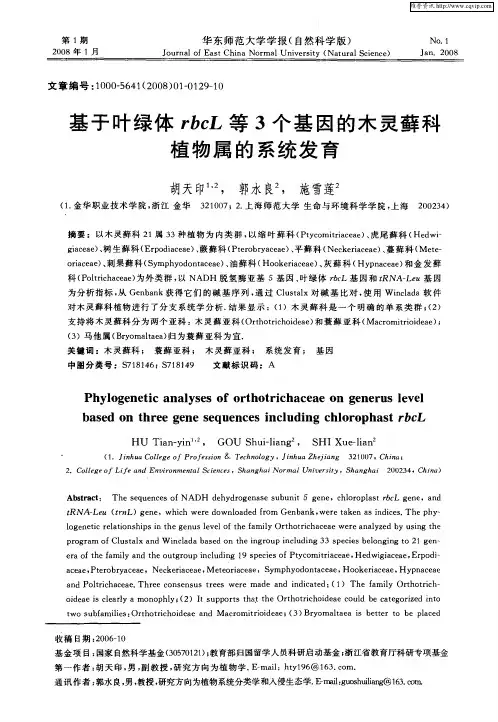
摘 要 :以 木 灵藓 科 2 1属 3 3种 植 物 为 内类 群 , 缩 叶 藓 科 ( tcmi i ee 、 尾 藓 科 ( d i 以 P yo ta a) 虎 rc He w— g ca)树 生藓 科 ( p daee 、 藓 科 ( trb yca)平 藓 科 ( cei ee 、 藓 科 ( t i ee 、 a Eroica )蕨 P eo raee 、 Nek r ca) 蔓 a Mee - oica) 刺 果 藓 科 ( y h o o tca )油 藓 科 ( o eica ) 灰 藓 科 ( p aee 和金 发 藓 r ee 、 a S mp yd naee 、 Ho k r ee 、 a Hy nca ) 科 ( oti aee 为外 类 群 , NA P l c ca) rh 以 DH 脱 氢 酶 亚 基 5基 因 、 叶绿 体 rc bL基 因 和 t NA L u基 因 R —e 为 分 析 指 标 , G n a k获 得 它 们 的碱 基 序 列 , 过 Cutl 碱 基 比对 , 用 W ic d 从 e bn 通 ls x对 a 使 nl a软 件 a 对 木 灵藓 科 植 物 进 行 了分 支 系 统 学 分 析 . 果 显 示 :( )木 灵 藓 科 是 一 个 明确 的 单 系 类 群 ;2 结 1 () 支 持 将 木灵 藓 科 分 为 两 个 亚 科 : 灵 藓 亚 科 ( rh t coda) 蓑 藓 亚 科 ( co ti da) 木 0 tor hjee 和 i Marmi o ee ; ri维普资讯 第 来自期 20 0 8年 1月
华东 师范 大学学 报 ( 自然科 学版 )
J u n l fEa t iaNo ma ie st Nau a ce c ) o r a s n r l o Ch Unv riy( t rl in e S
膜蕨科植物rbcL基因的适应性进化和共进化分析
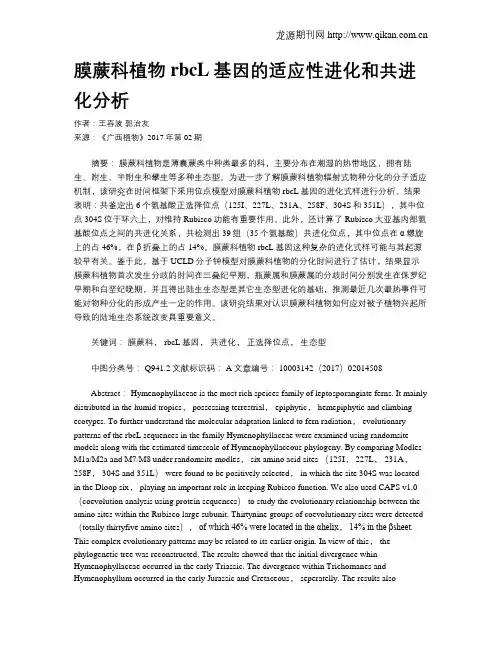
膜蕨科植物rbcL基因的适应性进化和共进化分析作者:王春波郭治友来源:《广西植物》2017年第02期摘要:膜蕨科植物是薄囊蕨类中种类最多的科,主要分布在潮湿的热带地区,拥有陆生、附生、半附生和攀生等多种生态型。
为进一步了解膜蕨科植物辐射式物种分化的分子适应机制,该研究在时间框架下采用位点模型对膜蕨科植物rbcL基因的进化式样进行分析。
结果表明:共鉴定出6个氨基酸正选择位点(125I、227L、231A、258F、304S和351L),其中位点304S位于环六上,对维持Rubisco功能有重要作用。
此外,还计算了Rubisco大亚基内部氨基酸位点之间的共进化关系,共检测出39组(35个氨基酸)共进化位点,其中位点在α螺旋上的占46%,在β折叠上的占14%。
膜蕨科植物rbcL基因这种复杂的进化式样可能与其起源较早有关。
鉴于此,基于UCLD分子钟模型对膜蕨科植物的分化时间进行了估计,结果显示膜蕨科植物首次发生分歧的时间在三叠纪早期,瓶蕨属和膜蕨属的分歧时间分别发生在侏罗纪早期和白垩纪晚期,并且得出陆生生态型是其它生态型进化的基础,推测最近几次最热事件可能对物种分化的形成产生一定的作用。
该研究结果对认识膜蕨科植物如何应对被子植物兴起所导致的陆地生态系统改变具重要意义。
关键词:膜蕨科, rbcL基因,共进化,正选择位点,生态型中图分类号: Q941.2文献标识码: A文章编号: 10003142(2017)02014508Abstract: Hymenophyllaceae is the most rich speices family of leptosporangiate ferns. It mainly distributed in the humid tropics, possessing terrestrial, epiphytic, hemepiphytic and climbing ecotypes. To further understand the molecular adaptation linked to fern radiation, evolutionary patterns of the rbcL sequences in the family Hymenophyllaceae were examined using randomsite models along with the estimated timescale of Hymenophyllaceous phylogeny. By comparing Modles M1a/M2a and M7/M8 under randomsite modles, six amino acid sites (125I, 227L, 231A,258F, 304S and 351L) were found to be positively selected, in which the site 304S was located in the Dloop six, playing an important role in keeping Rubisco function. We also used CAPS v1.0 (coevolution analysis using protein sequences) to study the evolutionary relationship between the amino sites within the Rubisco large subunit. Thirtynine groups of coevolutionary sites were detected (totally thirtyfive amino sites),of which 46% were located in the αhelix,14% in the βsheet. This complex evolutionary patterns may be related to its earlier origin. In view of this, the phylogenetic tree was reconstructed. The results showed that the initial divergence whin Hymenophyllaceae occurred in the early Triassic. The divergence within Trichomanes and Hymenophyllum occurred in the early Jurassic and Cretaceous, seperatelly. The results also indicated that the ancestral state for the Hymenophyllaceae was terrestrial, suggesting possible rolesplayed by the Thermal Maximum recently. These results provide new insights for how Hymenophyllaceae ferns response to the terrestrial ecosystem changes caused by the rise angiosperms.Key words: Hymenophyllaceae, rbcL gene, coevolution, positive selection, ecotypes核酮糖1,5二磷酸羧化酶/加氧酶(简称Rubisco),是叶绿体基质中的可溶性蛋白。
金粉蕨属系统位置--来自rbcL序列的证据
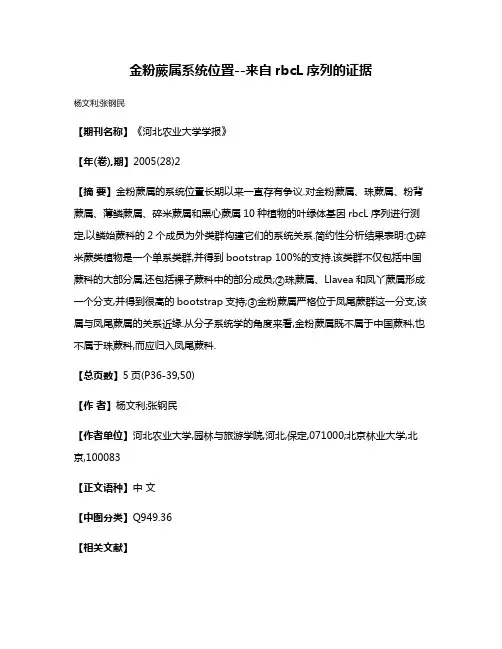
金粉蕨属系统位置--来自rbcL序列的证据杨文利;张钢民【期刊名称】《河北农业大学学报》【年(卷),期】2005(28)2【摘要】金粉蕨属的系统位置长期以来一直存有争议.对金粉蕨属、珠蕨属、粉背蕨属、薄鳞蕨属、碎米蕨属和黑心蕨属10种植物的叶绿体基因rbcL序列进行测定,以鳞始蕨科的2个成员为外类群构建它们的系统关系.简约性分析结果表明:①碎米蕨类植物是一个单系类群,并得到bootstrap 100%的支持.该类群不仅包括中国蕨科的大部分属,还包括裸子蕨科中的部分成员;②珠蕨属、Llavea和凤丫蕨属形成一个分支,并得到很高的bootstrap支持;③金粉蕨属严格位于凤尾蕨群这一分支,该属与凤尾蕨属的关系近缘.从分子系统学的角度来看,金粉蕨属既不属于中国蕨科,也不属于珠蕨科,而应归入凤尾蕨科.【总页数】5页(P36-39,50)【作者】杨文利;张钢民【作者单位】河北农业大学,园林与旅游学院,河北,保定,071000;北京林业大学,北京,100083【正文语种】中文【中图分类】Q949.36【相关文献】1.九子母属的系统位置:来自叶绿体rbcL序列及核核糖体ITS序列的证据 [J], 潘跃芝;龚洵;杨杨2.线蕨属(水龙骨科)的系统发育研究:来自叶绿体rbcL和rps4-trnS序列的证据 [J], 董晓东;陆树刚;李春香3.云南铁角蕨与泸山铁角蕨的关系:来自叶绿体rbcL、trnL-F和rps4-trnS序列的证据 [J], 李春香;陆树刚4.用叶绿体rbcL和rps4-trnS区序列确定亚洲特有单型属——篦齿蕨属的系统位置 [J], 陆树刚;李春香5.泽泻蕨的系统位置——来自rbcL序列的分析 [J], 张钢民;刘红梅;杨文利;张宪春因版权原因,仅展示原文概要,查看原文内容请购买。
青藏高原仲彬草属植物叶绿体rbcL序列的谱系分析
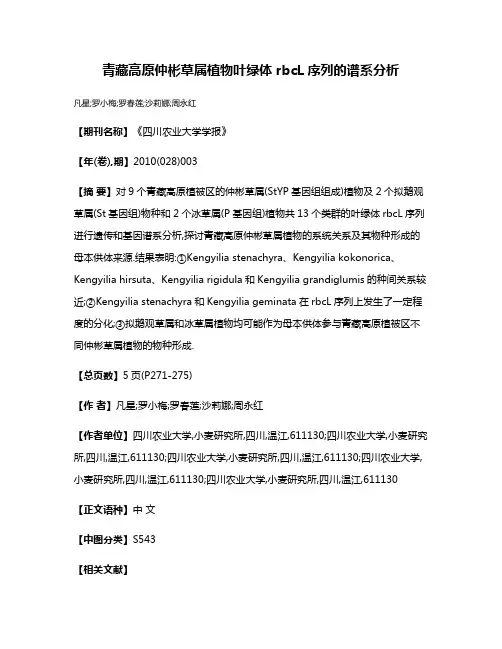
青藏高原仲彬草属植物叶绿体rbcL序列的谱系分析凡星;罗小梅;罗春莲;沙莉娜;周永红【期刊名称】《四川农业大学学报》【年(卷),期】2010(028)003【摘要】对9个青藏高原植被区的仲彬草属(StYP基因组组成)植物及2个拟鹅观草属(St基因组)物种和2个冰草属(P基因组)植物共13个类群的叶绿体rbcL序列进行遗传和基因谱系分析,探讨青藏高原仲彬草属植物的系统关系及其物种形成的母本供体来源.结果表明:①Kengyilia stenachyra、Kengyilia kokonorica、Kengyilia hirsuta、Kengyilia rigidula和Kengyilia grandiglumis的种间关系较近;②Kengyilia stenachyra和Kengyilia geminata在rbcL序列上发生了一定程度的分化;③拟鹅观草属和冰草属植物均可能作为母本供体参与青藏高原植被区不同仲彬草属植物的物种形成.【总页数】5页(P271-275)【作者】凡星;罗小梅;罗春莲;沙莉娜;周永红【作者单位】四川农业大学,小麦研究所,四川,温江,611130;四川农业大学,小麦研究所,四川,温江,611130;四川农业大学,小麦研究所,四川,温江,611130;四川农业大学,小麦研究所,四川,温江,611130;四川农业大学,小麦研究所,四川,温江,611130【正文语种】中文【中图分类】S543【相关文献】1.鹅观草属、披碱草属、猬草属和仲彬草属物种的酯酶同工酶分析 [J], 张春;周永红;于海清;凡星;张海琴2.仲彬草属植物ITS序列PCR产物直接测序与克隆测序比较分析 [J], 曾建;张利;凡星;张春;张海琴;周永红3.鹅观草属、披碱草属、猬草属和仲彬草属植物的RAPD分析及其系统学意义 [J], 周永红;郑有良;杨俊良;颜济;魏育明;杨瑞武4.基于叶绿体atpB-rbcL序列探讨猬草属和赖草属植物的系统发育和母系起源 [J], 刘静;张海琴;凡星;沙莉娜;曾建;周永红5.基于ITS序列分析仲彬草属植物的亲缘关系 [J], 张利;周永红;丁春邦;杨瑞武;凡星因版权原因,仅展示原文概要,查看原文内容请购买。
鳞毛蕨科植物的系统发育_叶绿体rbcL序列的证据
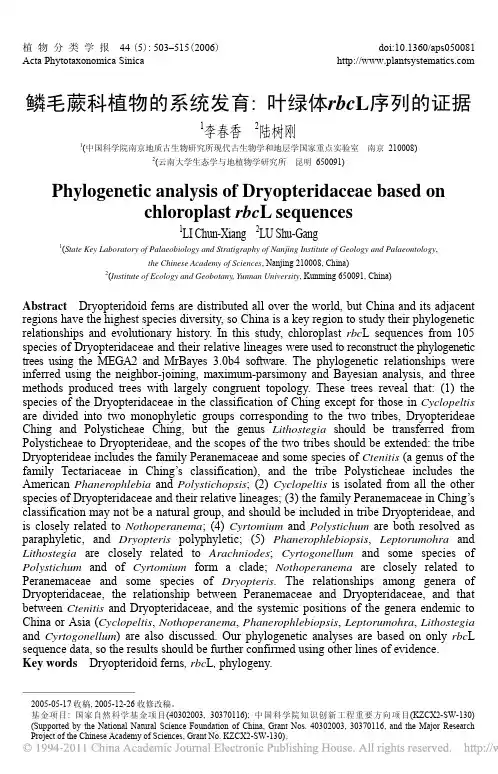
植物分类学报 44 (5): 503–515(2006) doi:10.1360/aps050081 Acta Phytotaxonomica Sinica 鳞毛蕨科植物的系统发育: 叶绿体rbc L序列的证据1李春香2陆树刚1(中国科学院南京地质古生物研究所现代古生物学和地层学国家重点实验室南京 210008)2(云南大学生态学与地植物学研究所昆明 650091)Phylogenetic analysis of Dryopteridaceae based onchloroplast rbc L sequences1LI Chun-Xiang 2LU Shu-Gang1(State Key Laboratory of Palaeobiology and Stratigraphy of Nanjing Institute of Geology and Palaeontology,the Chinese Academy of Sciences, Nanjing 210008, China)2(Institute of Ecology and Geobotany, Yunnan University, Kunming 650091, China)Abstract Dryopteridoid ferns are distributed all over the world, but China and its adjacent regions have the highest species diversity, so China is a key region to study their phylogenetic relationships and evolutionary history. In this study, chloroplast rbc L sequences from 105 species of Dryopteridaceae and their relative lineages were used to reconstruct the phylogenetic trees using the MEGA2 and MrBayes 3.0b4 software. The phylogenetic relationships were inferred using the neighbor-joining, maximum-parsimony and Bayesian analysis, and three methods produced trees with largely congruent topology. These trees reveal that: (1) the species of the Dryopteridaceae in the classification of Ching except for those in Cyclopeltis are divided into two monophyletic groups corresponding to the two tribes, Dryopterideae Ching and Polysticheae Ching, but the genus Lithostegia should be transferred from Polysticheae to Dryopterideae, and the scopes of the two tribes should be extended: the tribe Dryopterideae includes the family Peranemaceae and some species of Ctenitis (a genus of the family Tectariaceae in Ching’s classification), and the tribe Polysticheae includes the American Phanerophlebia and Polystichopsis; (2) Cyclopeltis is isolated from all the other species of Dryopteridaceae and their relative lineages; (3) the family Peranemaceae in Ching’s classification may not be a natural group, and should be included in tribe Dryopterideae, and is closely related to Nothoperanema; (4) Cyrtomium and Polystichum are both resolved as paraphyletic, and Dryopteris polyphyletic; (5) Phanerophlebiopsis, Leptorumohra and Lithostegia are closely related to Arachniodes; Cyrtogonellum and some species of Polystichum and of Cyrtomium form a clade; Nothoperanema are closely related to Peranemaceae and some species of Dryopteris. The relationships among genera of Dryopteridaceae, the relationship between Peranemaceae and Dryopteridaceae,and that between Ctenitis and Dryopteridaceae, and the systemic positions of the genera endemic to China or Asia (Cyclopeltis, Nothoperanema, Phanerophlebiopsis, Leptorumohra, Lithostegia and Cyrtogonellum) are also discussed. Our phylogenetic analyses are based on only rbc L sequence data, so the results should be further confirmed using other lines of evidence.Key words Dryopteridoid ferns, rbc L, phylogeny.———————————2005-05-17收稿, 2005-12-26收修改稿。
基于rbcL序列探讨荨麻科植物的系统发育关系
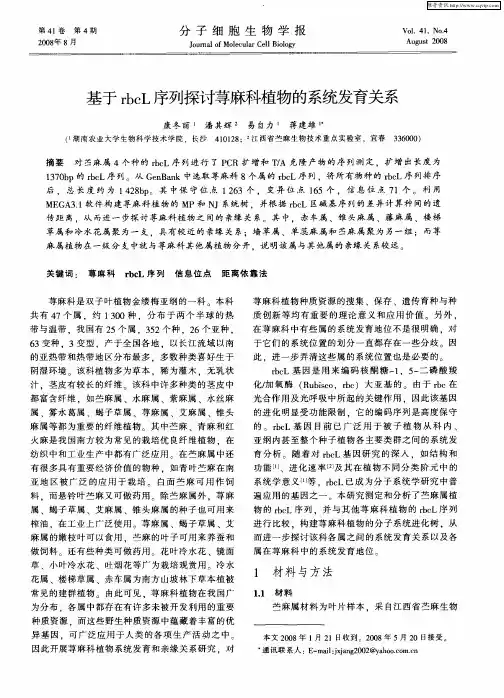
26 5
康冬 丽
潘其辉
物 的 rc bL序列 .并 与其 他荨 麻科 植物 的 rc b L序 列
进行 比较 .构建荨 麻科 植物 的分子系统 进化树 ,从 而进一 步探讨该 科各 属之 间的系统发 育关 系以及各 属在荨 麻科 中的系统发 育地位
做饲料 还有些种 类可 做药用 花叶冷 水花 、镜 面 草 、小 叶冷水花 、吐烟 花等广 为栽培观 赏用 。冷水 花属 、楼梯草 属 、赤车 属为南方 山坡林 下草本 植被
质 创新 等均 有重 要 的理论 意 义和 应用 价值 。另外 ,
在荨 麻科 中有些 属的系 统发育地 位不是很 明确 ,对
于它们 的系统位 置的划 分一直都 存在一 些分歧 。因
此 ,进一 步弄清 这些属 的系统位 置也是 必要 的。 rc bL基 因是 用 来 编码 核 酮糖 一 ,5 二磷 酸 羧 1 一 化/Ⅱ 酶 ( u i o b )大亚 基 的 。 由于 rc在 力氧 R bs ,rc c b
关键 词 : 荨 麻 科 r c 序 列 信 息 位 点 距 离 依 靠 法 bL
荨麻科是 双子 叶植物金缕 梅亚纲 的一科 本科
荨 麻科植 物种质 资源的搜集 、保存 、遗传 育种与种
共有 4 7个 属 .约 1 0 0种 .分 布 于两 个 半 球 的热 3
带 与温带 ,我 国有 2 5个属 ,3 2个种 ,2 个 亚种 , 5 6 6 3变种 ,3变型 ,产于全 国各地 ,以长江流 域 以南
苎麻属材 料为 叶片样本 .采 自江西省 苎麻生物
本文 2 0 0 8年 1月 2 1日收 到 。2 0 0 8年 5月 2 0日接受 。 通 讯 联 系 人 : - a : jn 2 0 y h o o . E m ij ag0 2 ao. m c lx c a
基于DNA条形码技术鉴别5种列当属药用植物
基于DNA条形码技术鉴别5种列当属药用植物韩奇亨;汤健;王晓琴;李旻辉【期刊名称】《中国现代中药》【年(卷),期】2017(019)007【摘要】目的:建立一种快速、准确、标准化的5种列当属药用植物的DNA条形码鉴别方法.方法:采集5种列当属药用植物,所有样品进行总DNA提取,PCR扩增,并对扩增产物进行测序得到相应的序列,测序结果使用CONTIG、BioEdit、MEGA6.0软件进行分析,构建系统发育树.结果:测得5种列当属植物的ITS、rbcL、trnL-F和matK全长序列共200条,4种序列长度范围在364~1240 bp,其中ITS、trnL-F和matK可将其鉴别出来.结论:rbcL序列无法有效鉴别5种列当属药用植物,trnL-F与ITS序列能够成功鉴别,可作为列当属植物的分子鉴别方法.【总页数】8页(P917-923,959)【作者】韩奇亨;汤健;王晓琴;李旻辉【作者单位】包头医学院,内蒙古包头014060;包头医学院,内蒙古包头014060;内蒙古医科大学药学院,内蒙古呼和浩特010110;包头医学院,内蒙古包头014060;内蒙古自治区中医药研究所,内蒙古呼和浩特010110;内蒙古自治区特色药用植物培育与保护工程技术研究中心,内蒙古包头014060;内蒙古自治区特色道地药材资源保护与利用重点实验室,内蒙古包头014060【正文语种】中文【相关文献】1.基于DNA条形码ITS2序列对阿魏属药用植物的鉴别研究 [J], 刘冲;杨伟俊;何江;程波;地力努尔·吐尔逊江2.基于COI序列的DNA微条形码技术鉴别熟肉制品中11种肉掺假的研究 [J], 励炯;江海;吴琼;扈明洁;赵琪奇;金朦娜;邱红钰3.基于DNA条形码技术对朝鲜牛黄安宫丸中犀牛角成分鉴别的研究 [J], 王殿夫;齐欣;李长征;刘洪伟;麻丽丹;杨希国4.基于细胞色素C氧化酶亚基Ⅰ序列的DNA微条形码技术鉴别11种生鲜肉制品掺假的研究 [J], 励炯;吴琼;扈明洁;金朦娜;邱红钰5.基于DNA条形码技术鉴别有毒鹅膏菌属物种 [J], 白文明;邢冉冉;陈丽萍;彭涛;雷红涛;陈颖因版权原因,仅展示原文概要,查看原文内容请购买。
小球藻核rDNA ITS与叶绿体rbcL基因序列分析及应用
小球藻核rDNA ITS与叶绿体rbcL基因序列分析及应用孙雪;吴晓微;李兴文;裴鲁青【期刊名称】《水产学报》【年(卷),期】2009(33)4【摘要】用核基因组rDNA的内转录间隔区(ITS)和叶绿体rbcL基因对小球藻属((Jhlorella)6株小球藻的种间和种内关系进行了分析.克隆序列与GenBank数据库检索到的相关小球藻序列(ITS和rbcL序列各为15条)一起进行比较分析.结果显示:ITS序列长度在小球藻种内高度保守,在种间变异较大;而rbcL序列长度在种间和种内水平都高度保守.15株小球藻ITS序列间遗传距离在0.000~0.663.之间;而15株小球藻rbcL序列间距离在0.000~0.216之间.6株实验藻中原始小球藻F-2与蛋白核小球藻F-5、F-9近似种内关系;蛋白核小球藻820与普通小球藻Cvq亲缘关系极近;椭圆小球藻Ce与其它5株小球藻亲缘关系最远.研究表明将变异程度较高的核ITS序列与相对保守的叶绿体rbcL基因相结合可以用于小球藻系统发生分析和分子鉴定.【总页数】7页(P565-571)【作者】孙雪;吴晓微;李兴文;裴鲁青【作者单位】宁波大学教育部应用海洋生物工程重点实验室,浙江,宁波,315211;宁波大学教育部应用海洋生物工程重点实验室,浙江,宁波,315211;宁波大学教育部应用海洋生物工程重点实验室,浙江,宁波,315211;宁波大学教育部应用海洋生物工程重点实验室,浙江,宁波,315211【正文语种】中文【中图分类】Q781【相关文献】1.蛋白核小球藻核酮糖-1,5-二磷酸羧化/加氧酶小亚基部分基因序列的克隆与分析[J], 孙雪;马斌;周成旭2.木兰亚纲的分子系统学研究进展:(一)叶绿体rbcL基因序列的分支分析 [J], 王艇;Park.,CP3.叶绿体rbcL基因序列在植物系统学研究中的应用 [J], 王艇;苏应娟4.基于叶绿体trnL-F,rbcL序列和核核糖体ITS序列探讨蓼属(蓼科)头状蓼组的系统发育 [J], 赵大鹏;王康满;侯元同5.基于叶绿体基因序列rbcL-accD研究莛子藨的分子遗传多样性和谱系地理结构[J], 刘海瑞;高庆波;张发起;邢睿;迟晓峰;陈世龙因版权原因,仅展示原文概要,查看原文内容请购买。
鳞毛蕨科3种植物配子体发育的研究
鳞毛蕨科3种植物配子体发育的研究李懿宸;齐晶;郑书忆;张剑锋;戴锡玲【期刊名称】《植物研究》【年(卷),期】2016(36)3【摘要】利用光学显微镜详细观察鳞毛蕨科(Dryopteridaceae)3属3种植物,即耳蕨属的棕鳞耳蕨(Polystichum polyblepharum)、鳞毛蕨属的黑足鳞毛蕨(Dryopteris fuscipes)和鞭叶蕨属的鞭叶蕨(Cyrtomidictyum lepidocaulon)配子体发育过程,记录配子体各发育阶段的特征。
结果表明:棕鳞耳蕨、黑足鳞毛蕨和鞭叶蕨的孢子都为单裂缝,孢子萌发类型为书带蕨型,配子体发育类型为三叉蕨型,性器官为薄囊蕨型,成熟原叶体为对称的心脏形,具毛状体;3属的属间差异包括孢子颜色、孢子纹饰、萌发时间、丝状体长度、片状体形状、毛状体和假根等特征,上述特征在属间存在交叉现象,因此,孢子形态和配子体发育特征不能作为区分耳蕨属、鳞毛蕨属和鞭叶蕨属的形态依据。
【总页数】7页(P334-340)【关键词】鳞毛蕨科;棕鳞耳蕨;黑足鳞毛蕨;鞭叶蕨;配子体发育【作者】李懿宸;齐晶;郑书忆;张剑锋;戴锡玲【作者单位】上海师范大学生命与环境科学学院【正文语种】中文【中图分类】S682.35【相关文献】1.东北蕨类植物配子体发育的研究X.岩蕨科 [J], 包文美;林孝辉;王全喜;敖志文2.东北蕨类植物配子体发育的研究Ⅵ.中国蕨科 [J], 包文美;王全喜;敖志文3.乌毛蕨科3种植物配子体发育的研究 [J], 王玥;赵金博;王金娟;王晓楠;刘保东4.东北蕨类植物配子体发育的研究Ⅸ蹄盖蕨科 [J], 林孝辉;王全喜;包文美;敖志文5.4种蹄盖蕨科植物配子体形态和发育的比较研究 [J], 戴锡玲;沈卓彦;王佳;叶雯婷因版权原因,仅展示原文概要,查看原文内容请购买。
串珠藻目植物rbcL基因的适应性进化分析
串珠藻目植物rbcL基因的适应性进化分析巩超彦;南芳茹;冯佳;吕俊平;刘琪;谢树莲【期刊名称】《海洋与湖沼》【年(卷),期】2017(48)3【摘要】Freshwater red algae are an important lineage in algal evolution.Batrachospermales is an order with the most species.Ribulose-l,5 bisphosphate carboxylase/oxygenase (Rubisco) is an enzyme responsible for both carbon assimilation and photorespiration,and plays an important role in plant photosynthesis.The Rubisco large subunit containing active sites for catalyzing CO2 fixation,is encoded by chloroplast rbcL gene.To explore the molecular mechanism of algal adaption to special living environment,39 rbcL genes of Batrachospermales and other relative taxa were selected to analyze the adaptive ing softwarePAML4.8,the site model,branch model,and branch-site model were tested.The results show that (1) in the phylogenetic tree constructed by the maximum likelihood method,all the internal groups cluster into six branches,i.e.,Cluster A is Bangia atropurpurea,B is Batrachospermum gelatinosum,C is B.helminthosum,D is the genus Kumanoa,E is the genus Sirodotia,and F is Sheathia arcuata;(2) 350S,277L,and 280L are identified as positive selection sites on three branches in the branch-site model;(3) in the reference three-dimensional model of Rubisco large subunit,277L and 280L are located in a loop between the 7th αt helix and the 7th β sheet ofthe conserved αt/β-barrel domain that consists of 8 α-helices and 8 β-sheets at the C-terminus,and 350S is located on an α helix in the C-terminus adjacent to the α/β-barrel domain.Therefore,the results demonstrated the accuracy and effectiveness of examining the adaptive evolution of gene based on ω ratio,and revealed that the rbcL gene has undergone adaptive evolution,which has been beneficial to Batrachospermales for the adaption to the special living environment.%淡水红藻是藻类植物进化中的一个重要类群,其中最主要的类群是串珠藻目.核酮糖1,5二磷酸羧化酶/力氧酶(Rubisco)是一种既负责碳同化又引发光呼吸,在植物光合作用中起重要作用的酶,其催化固定CO2的活性中心位于Rubisco大亚基,由叶绿体rbcL基因编码.为了探究串珠藻目植物适应特殊生存环境的分子水平机制,本文选取了串珠藻目及一些相近类群淡水红藻的rbcL基因39条,利用PAML4.8软件,运行位点模型、分支模型及分支-位点模型,对选取类群的rbcL基因进行了适应性进化分析.结果表明:(1)通过最大似然法构建的系统发育树显示,所有内类群聚集为6个分支,其中,分支A为暗紫红毛菜,分支B为胶串珠藻,分支C为扁圆串珠藻,后验概率同样为100%,分支D为熊野藻属,分支E为连珠藻属,分支F为弧形西斯藻;(2)分支-位点模型中,在3个分支中分别鉴定出350S、277L和280L为正选择位点;(3)在构建出的Rubisco大亚基的参考三维模型中,277L和280L位于Rubisco大亚基羧基末端保守的8个α螺旋和8个β片层构成的α/β桶状结构域中第7个α螺旋和第7个β片层之间的loop结构上,350S位于羧基末端邻近α/p桶状结构域的一个α螺旋上.研究结果一方面显示了基于ω比值检验基因适应性进化的准确性和有效性,另一方面也揭示了串珠藻目植物rbcL基因确实发生了适应性进化,对串珠藻目适应特殊生存环境产生了有益的作用.【总页数】9页(P527-535)【作者】巩超彦;南芳茹;冯佳;吕俊平;刘琪;谢树莲【作者单位】山西大学生命科学学院太原030006;山西大学生命科学学院太原030006;山西大学生命科学学院太原030006;山西大学生命科学学院太原030006;山西大学生命科学学院太原030006;山西大学生命科学学院太原030006【正文语种】中文【中图分类】Q941【相关文献】1.凤尾蕨科植物rbcL基因的适应性进化分析 [J], 森林;苏应娟;张冰;王艇2.串珠藻目植物的系统发育-基于rbcL序列的证据 [J], 李强;吉莉;谢树莲3.基于SSU序列的串珠藻目植物系统发育分析 [J], 吉莉;陈乐;冯佳;谢树莲4.弯枝藻属rbcL基因的适应性进化分析 [J], 韩雨昕;南芳茹;巩超彦;冯佳;吕俊平;刘琪;谢树莲5.念珠藻属植物hetR基因的适应性进化分析 [J], 王捷; 魏爱丽; 石瑛; 李艳晖; 韩雨昕; 王中杰因版权原因,仅展示原文概要,查看原文内容请购买。
- 1、下载文档前请自行甄别文档内容的完整性,平台不提供额外的编辑、内容补充、找答案等附加服务。
- 2、"仅部分预览"的文档,不可在线预览部分如存在完整性等问题,可反馈申请退款(可完整预览的文档不适用该条件!)。
- 3、如文档侵犯您的权益,请联系客服反馈,我们会尽快为您处理(人工客服工作时间:9:00-18:30)。
植物分类学报 44 (5): 503–515(2006) doi:10.1360/aps050081 Acta Phytotaxonomica Sinica 鳞毛蕨科植物的系统发育: 叶绿体rbc L序列的证据1李春香2陆树刚1(中国科学院南京地质古生物研究所现代古生物学和地层学国家重点实验室南京 210008)2(云南大学生态学与地植物学研究所昆明 650091)Phylogenetic analysis of Dryopteridaceae based onchloroplast rbc L sequences1LI Chun-Xiang 2LU Shu-Gang1(State Key Laboratory of Palaeobiology and Stratigraphy of Nanjing Institute of Geology and Palaeontology,the Chinese Academy of Sciences, Nanjing 210008, China)2(Institute of Ecology and Geobotany, Yunnan University, Kunming 650091, China)Abstract Dryopteridoid ferns are distributed all over the world, but China and its adjacent regions have the highest species diversity, so China is a key region to study their phylogenetic relationships and evolutionary history. In this study, chloroplast rbc L sequences from 105 species of Dryopteridaceae and their relative lineages were used to reconstruct the phylogenetic trees using the MEGA2 and MrBayes 3.0b4 software. The phylogenetic relationships were inferred using the neighbor-joining, maximum-parsimony and Bayesian analysis, and three methods produced trees with largely congruent topology. These trees reveal that: (1) the species of the Dryopteridaceae in the classification of Ching except for those in Cyclopeltis are divided into two monophyletic groups corresponding to the two tribes, Dryopterideae Ching and Polysticheae Ching, but the genus Lithostegia should be transferred from Polysticheae to Dryopterideae, and the scopes of the two tribes should be extended: the tribe Dryopterideae includes the family Peranemaceae and some species of Ctenitis (a genus of the family Tectariaceae in Ching’s classification), and the tribe Polysticheae includes the American Phanerophlebia and Polystichopsis; (2) Cyclopeltis is isolated from all the other species of Dryopteridaceae and their relative lineages; (3) the family Peranemaceae in Ching’s classification may not be a natural group, and should be included in tribe Dryopterideae, and is closely related to Nothoperanema; (4) Cyrtomium and Polystichum are both resolved as paraphyletic, and Dryopteris polyphyletic; (5) Phanerophlebiopsis, Leptorumohra and Lithostegia are closely related to Arachniodes; Cyrtogonellum and some species of Polystichum and of Cyrtomium form a clade; Nothoperanema are closely related to Peranemaceae and some species of Dryopteris. The relationships among genera of Dryopteridaceae, the relationship between Peranemaceae and Dryopteridaceae,and that between Ctenitis and Dryopteridaceae, and the systemic positions of the genera endemic to China or Asia (Cyclopeltis, Nothoperanema, Phanerophlebiopsis, Leptorumohra, Lithostegia and Cyrtogonellum) are also discussed. Our phylogenetic analyses are based on only rbc L sequence data, so the results should be further confirmed using other lines of evidence.Key words Dryopteridoid ferns, rbc L, phylogeny.———————————2005-05-17收稿, 2005-12-26收修改稿。
基金项目: 国家自然科学基金项目(40302003, 30370116); 中国科学院知识创新工程重要方向项目(KZCX2-SW-130) (Supported by the National Natural Science Foundation of China, Grant Nos. 40302003, 30370116, and the Major Research Project of the Chinese Academy of Sciences, Grant No. KZCX2-SW-130)。
504植物分类学报 44卷摘要运用MEGA2和MrBayes 3.0b4软件包对105种鳞毛蕨类及近缘植物(其中新测定36种)的叶绿体DNA rbc L基因序列进行系统发育分析, 探讨了其主要分类群(属级水平)的系统演化关系。
用最大简约法、邻接法和贝叶斯分析方法构建的系统树基本一致, 结果显示: (1)秦仁昌系统所定义的鳞毛蕨科Dryopteridaceae, 除了拟贯众属Cyclopeltis外, 均包含在两个单系群之中, 支持鳞毛蕨族Dryopterideae和耳蕨族Polysticheae的成立; 但是鳞毛蕨族还包含秦仁昌系统所定义的球盖蕨科Peranemaceae和三叉蕨科Tectariaceae肋毛蕨属Ctenitis的部分种类; 耳蕨族还包含产于美洲的Phanerophlebia属和Polystichopsis 属; 确认石盖蕨属Lithostegia属鳞毛蕨族的成员, 且与复叶耳蕨属Arachniodes具有较近的亲缘关系。
(2)拟贯众属与所分析的其他任何鳞毛蕨类植物的关系都比较疏远, 单独为一支。
(3)秦仁昌系统所定义的球盖蕨科与肉刺蕨属Nothoperanema聚成一个分支, 属于鳞毛蕨族的成员。
(4)鳞毛蕨属Dryopteris为多系类群, 耳蕨属Polystichum和贯众属Cyrtomium均为并系类群。
(5)黔蕨属Phanerophlebiopsis、毛枝蕨属Leptorumohra和石盖蕨属与复叶耳蕨属构成一支; 柳叶蕨属Cyrtogonellum与Polystichum属和Cyrtomium 属的部分种类聚成一支; 肉刺蕨属与球盖蕨科及鳞毛蕨属的部分种类聚成一支。
对鳞毛蕨科的系统关系、球盖蕨科与鳞毛蕨科的系统关系、肋毛蕨属与鳞毛蕨科的系统关系以及中国或亚洲特有属(拟贯众属、肉刺蕨属、黔蕨属、毛枝蕨属、石盖蕨属和柳叶蕨属)的系统位置进行了讨论。
关键词鳞毛蕨类植物; rbc L; 系统发育中国是鳞毛蕨类植物种类最丰富的地区, 因此, 中国也是研究鳞毛蕨类植物系统演化关系的最关键地区。
鳞毛蕨类植物类群多, 分类难度大, 其主要类群间的系统演化关系一直是蕨类植物学家争论不休的问题, 属间界限也有待进一步研究。
有关鳞毛蕨科Dryopteridaceae分类范畴的界定问题, 至今尚存在较大差异。
鳞毛蕨类植物过去一直置于三叉蕨科Tectariaceae (Aspidiaceae) (Ching, 1940)。
秦仁昌(1965)正式提出把鳞毛蕨类植物从三叉蕨科独立出来, 成立了鳞毛蕨科Dryopteridaceae, 包括13个属, 并根据囊群盖的形态和着生方式, 将其分为鳞毛蕨族Dryopterideae和耳蕨族Polysticheae。
秦仁昌(1940, 1978)还将与鳞毛蕨科相近的柄盖蕨属Peranema Don、鱼鳞蕨属Acrophorus Presl及红腺蕨属Diacalpe Bl.另成立为球盖蕨科Peranemaceae。
